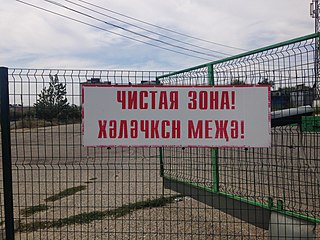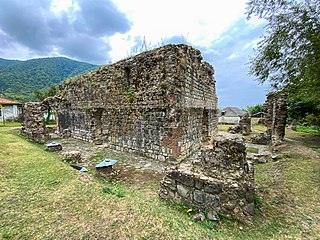
Circassia, also known as Zichia, was a country and a historical region in the North Caucasus. Located along the northeastern shore of the Black Sea, it was conquered by the Russian Empire during the Russo-Circassian War (1763–1864), after which approximately 90% of the Circassian people were either exiled or massacred in the Circassian genocide.

Kalmyk Oirat, commonly known as the Kalmyk language, is a variety of the Oirat language, natively spoken by the Kalmyk people of Kalmykia, a federal subject of Russia. In Russia, it is the standard form of the Oirat language, which belongs to the Mongolic language family. The Kalmyk people of the Northwest Caspian Sea of Russia claim descent from the Oirats from Eurasia, who have also historically settled in Mongolia and Northwest China. According to UNESCO, the language is "Definitely endangered". According to the Russian census of 2021, there are 110,000 speakers of an ethnic population consisting of 178,000 people.
The Russo-Crimean Wars were fought between the forces of the Tsardom of Russia and the Crimean Khanate during the 16th century over the region around the Volga River.

The Chosroid dynasty, also known as the Iberian Mihranids, were a dynasty of the kings and later the presiding princes of the early Georgian state of Iberia from the 4th to the 9th centuries. The family, of Iranian Mihranid origin, accepted Christianity as their official religion c. 337, and maneuvered between the Byzantine Empire and Sassanid Iran to retain a degree of independence. After the abolition of the Iberian kingship by the Sassanids c. 580, the dynasty survived in its two closely related, but sometimes competing princely branches—the elder Chosroid and the younger Guaramid—down to the early ninth century when they were succeeded by the Georgian Bagratids on the throne of Iberia.

Arts of Caucasian Albania – is the historical and regional type of arts related to Ancient East.

The Gum basilica is a three-aisled, domed Albanian temple of the 6–7th centuries, located in the Gum village of the Gakh district of Azerbaijan. In the scientific literature, the temple is called a basilica,. Has typological similarities with some earlier temples in Armenia and Georgia
Yekaterina Ivanovna Yezhova (1787–1837), was a Russian Empire stage actress. She was a leading celebrated star at the Imperial Theatre of Saint Petersburg in 1805–1837 and also a salon hostess, known for her relationship with Prince Alexander Shakhovskoy.

The Etymological Dictionary of Slavic Languages: Proto-Slavic Lexical Stock is an etymological dictionary of the reconstructed Proto-Slavic lexicon. It has been continuously published since 1974 until present, in 43 volumes, making it one of the most comprehensive in the world.

Sahakanuysh was the third Queen of the Bagratid Kingdom and member of Aranshahik Dynasty. She was the wife of the third Bagratuni king - Ashot the Iron (914-928).

The KrAZ-214 is an off-road truck 6x6 for extreme operations. It was manufactured at the YaMZ plant from 1956-1959, after which production was moved to KrAZ. The model line was the successor to the YaG-10 trucks.
Ilya Sholeimovich Shifman (Russian: Илья́ Шо́леймович Ши́фман was a Soviet historian, Orientalist and Classics scholar. He was awarded the degree Doctor of Historical Sciences in 1973; he worked at the Institute of Oriental Studies of the Russian Academy of Sciences Leningrad department.
The Komi language, a Uralic language spoken in the north-eastern part of European Russia, has been written in several different alphabets. Currently, Komi writing uses letters from the Cyrillic script. There have been five distinct stages in the history of Komi writing:

Sakasena is a historical region on the territory of modern Azerbaijan. The former core of the 7th - 6th century BCE of the Scythian kingdom of Ishkuz. It got its name from the tribes of the Scythians, who later entered the tribal union of the Caucasian Albanians. At the end of the 6th - beginning of the 5th century BCE it was part of the satrapy Media under the Achaemenid Empire. At the beginning of the 2nd century BCE it was annexed to Greater Armenia, becoming the Gavar (district) of the Nahanga (province) of Utic. In the division of Great Armenia in 387, it went to the Caucasian Albania, which was, under the treaty, subordinate to the Sassanids. It was located South of the middle course of the Kura, in the area of modern Ganja.
Since its inception in the 18th century and up to the present, it is based on the Cyrillic alphabet to write the Udmurt language. Attempts were also made to use the Latin alphabet to write the Udmurt language. In its modern form, the Udmurt alphabet was approved in 1937.
Sparama was the queen consort of the Mihranid king Varaz-Tiridates I of Caucasian Albania. She served as regent during the absence of her spouse in 694-699.
Khakass alphabets are the alphabets used to write the Khakas language.
Vardan II, was the Mihranid king of Caucasian Albania from 705 to 711.
Stephanos I was the Mihranid king of Caucasian Albania from 770 to 800 and the son of the previous ruler Gagikh II.
Varaz-Trdat II was the last Mihranid king of Caucasian Albania from 800 to 812/822 and the son of the previous ruler Stephanos I.

Moscow Courtyard is a landscape painting by the Russian artist Vasily Polenov (1844–1927), completed in 1878. It belongs to the State Tretyakov Gallery. Its dimensions are 64.5 × 80.1 cm. Together with two other works by Polenov from the late 1870s: the paintings Grandmother's Garden and Overgrown Pond, the canvas Moscow Courtyard has been attributed to "a kind of lyrical and philosophical trilogy of the artist".










